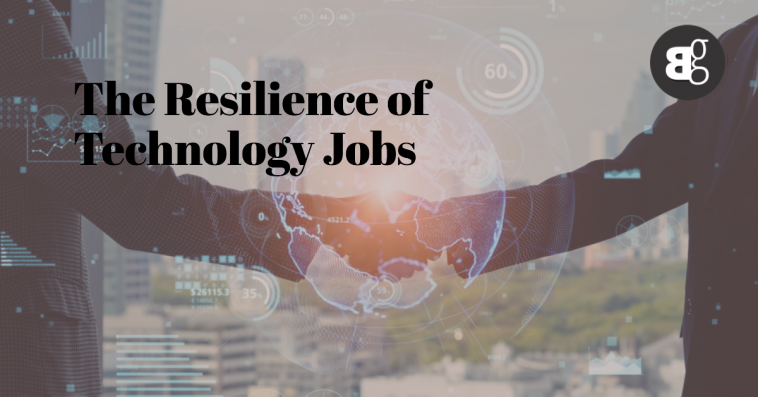The route that the industry for recruiting in technology will take was incredibly unpredictable as 2023 got underway. Due to the pandemic’s pent-up demand, we enjoyed two boom years. However, with negative economic indicators like rising prices, raging inflation, and rising interest rates, would that continue?
Given the “protected” position of technology, we trusted our intuition and assumed the market would be resilient. Organizations simply must continue investing in the digital transformation agenda, and to do that, they need to have the right people and the right capabilities.
A market that is more stable
We’re happy to report that this has held true six months later. In fact, during the first quarter of this year, our mandates for permanent placement were at the same level as they were in 2022, one of the post-Covid boom years.
Nevertheless, as the year has progressed, activity levels have decreased. The market was already moving at a rapid pace, so this is not necessarily a bad thing. It has steadied now, becoming more measured and less frantic. We have likely returned to the conditions that existed before the coronavirus was ever known to exist. Organizations are giving hiring decisions more thought; they are pausing to ponder before making an offer; and there is less of the intense competition that there once was.
Additionally, candidates have gotten a little more prudent. They are carefully assessing the potential benefits of a change against the possible risks in a tighter market and economy.
Sector differences
Additionally, there are noticeable sectoral inequalities in the market. Naturally, major businesses in the IT industry have been downsizing their workforces, which regrettably has resulted in some substantial layoffs. However, this trend has been waning, and in some places, we are actually starting to notice signs of an upsurge.
The technology market’s SME segment has also been impacted. Due to the difficulty in obtaining funding for scaleups and startups (tech startup funding in the US fell by 55% during Q1 for example), recruitment has been impacted, and hires have become more selective and aimed at particular goals. Retail and FMCG industries, which heavily rely on consumer demand, have also seen a decline in activity.
However, other industries have remained relatively stable and strong. For instance, strategic digital transformation plans and requirements at public sector organizations and higher education institutions have driven them to keep hiring. The financial services industry has remained active as well, with the major firms expanding their core operations, while there has been some tightness among the challengers.
Overall, there are four distinct themes worth highlighting:
1. Contractors
We anticipated a change (roughly speaking) from permanent to contractor hires six months ago. In fact, we are only now starting to notice the first indications of that, which is yet another measure of how resilient the market has been. In contrast, what we have observed with regard to contractor hires is that employers are bringing in resources for particular and specified tasks, and once those have been completed, they are more likely to let the contractors go rather than finding them other projects to work on.
2. The need for new digital leaders
Executives and leaders in the digital sector are in high demand. A new generation of digital leaders is required, especially for bigger enterprise clients, in order to move the company towards product-led, cloud-based environments and systems. Organizations require leaders who can negotiate shifting operational models, technological change, economic difficulties, and unforeseen global events. In a world where change is the one constant, they need to discover the “Ted Lassos” of technology.
3. Disruptive generative AI?
We can’t write about change and disruption without at least addressing generative AI, like ChatGPT. We simply don’t know yet how this might affect the work that people do as opposed to robots and, thus, the requirement for recruiting. But it will undoubtedly cause disruption. We urge every CIO, CTO, and CDO to thoroughly research generative AI and determine what possibilities it might offer for their company. Copilot for Github, for instance, enhanced developer productivity by 55.8%, according to research from Github, Microsoft, and the Massachusetts Institute of Technology (MIT).
4. Salary heat beginning to cool
Of course, salaries have been a popular topic as well. On the larger macroeconomic stage, it is very much a hot topic right now, with the Bank of England identifying salary rises as one of the key contributors to national inflation. The Digital Leadership Report from last year indicated that more than half of digital executives were worried about the sustainability of compensation increases in the technology industry.
We predicted that IT salaries will probably peak six months ago. Even if the trend is still upward, there are indications that this is starting to happen. Undoubtedly, salaries and contract rates haven’t continued to rise at the breathtaking rate they did a few years ago. For employers who must regularly monitor budgets and expenses, this moderation is welcome news.
A fair outlook
We anticipate that the market will remain in a largely healthy state until the second half of 2023. Indeed, we might witness a new acceleration in activity as optimism rises in the hopes that inflation will finally start to decline and cost pressures will ease.
Despite the fact that there is still a need for specialists in fields like engineering, data analytics, cloud/DevOps, and product development, there are chances for both recruiters and job seekers in this sector.





